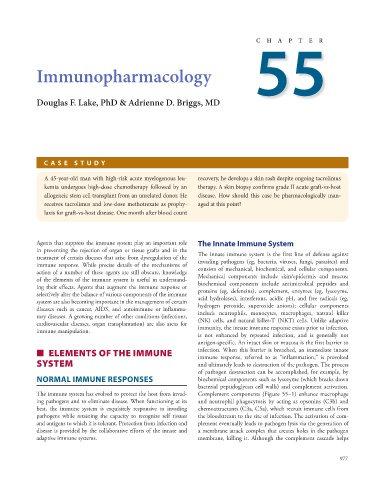Page 991 - Basic _ Clinical Pharmacology ( PDFDrive )
P. 991
55
P
H
C
A
T
E
R
Immunopharmacology
Douglas F. Lake, PhD & Adrienne D. Briggs, MD
C ASE STUD Y
A 45-year-old man with high-risk acute myelogenous leu- recovery, he develops a skin rash despite ongoing tacrolimus
kemia undergoes high-dose chemotherapy followed by an therapy. A skin biopsy confirms grade II acute graft-vs-host
allogeneic stem cell transplant from an unrelated donor. He disease. How should this case be pharmacologically man-
receives tacrolimus and low-dose methotrexate as prophy- aged at this point?
laxis for graft-vs-host disease. One month after blood count
Agents that suppress the immune system play an important role The Innate Immune System
in preventing the rejection of organ or tissue grafts and in the
treatment of certain diseases that arise from dysregulation of the The innate immune system is the first line of defense against
immune response. While precise details of the mechanisms of invading pathogens (eg, bacteria, viruses, fungi, parasites) and
action of a number of these agents are still obscure, knowledge consists of mechanical, biochemical, and cellular components.
of the elements of the immune system is useful in understand- Mechanical components include skin/epidermis and mucus;
ing their effects. Agents that augment the immune response or biochemical components include antimicrobial peptides and
selectively alter the balance of various components of the immune proteins (eg, defensins), complement, enzymes (eg, lysozyme,
system are also becoming important in the management of certain acid hydrolases), interferons, acidic pH, and free radicals (eg,
diseases such as cancer, AIDS, and autoimmune or inflamma- hydrogen peroxide, superoxide anions); cellular components
tory diseases. A growing number of other conditions (infections, include neutrophils, monocytes, macrophages, natural killer
cardiovascular diseases, organ transplantation) are also areas for (NK) cells, and natural killer-T (NKT) cells. Unlike adaptive
immune manipulation. immunity, the innate immune response exists prior to infection,
is not enhanced by repeated infection, and is generally not
antigen-specific. An intact skin or mucosa is the first barrier to
■ ELEMENTS OF THE IMMUNE infection. When this barrier is breached, an immediate innate
immune response, referred to as “inflammation,” is provoked
SYSTEM and ultimately leads to destruction of the pathogen. The process
of pathogen destruction can be accomplished, for example, by
NORMAL IMMUNE RESPONSES biochemical components such as lysozyme (which breaks down
bacterial peptidoglycan cell walls) and complement activation.
The immune system has evolved to protect the host from invad- Complement components (Figure 55–1) enhance macrophage
ing pathogens and to eliminate disease. When functioning at its and neutrophil phagocytosis by acting as opsonins (C3b) and
best, the immune system is exquisitely responsive to invading chemoattractants (C3a, C5a), which recruit immune cells from
pathogens while retaining the capacity to recognize self tissues the bloodstream to the site of infection. The activation of com-
and antigens to which it is tolerant. Protection from infection and plement eventually leads to pathogen lysis via the generation of
disease is provided by the collaborative efforts of the innate and a membrane attack complex that creates holes in the pathogen
adaptive immune systems. membrane, killing it. Although the complement cascade helps
977

